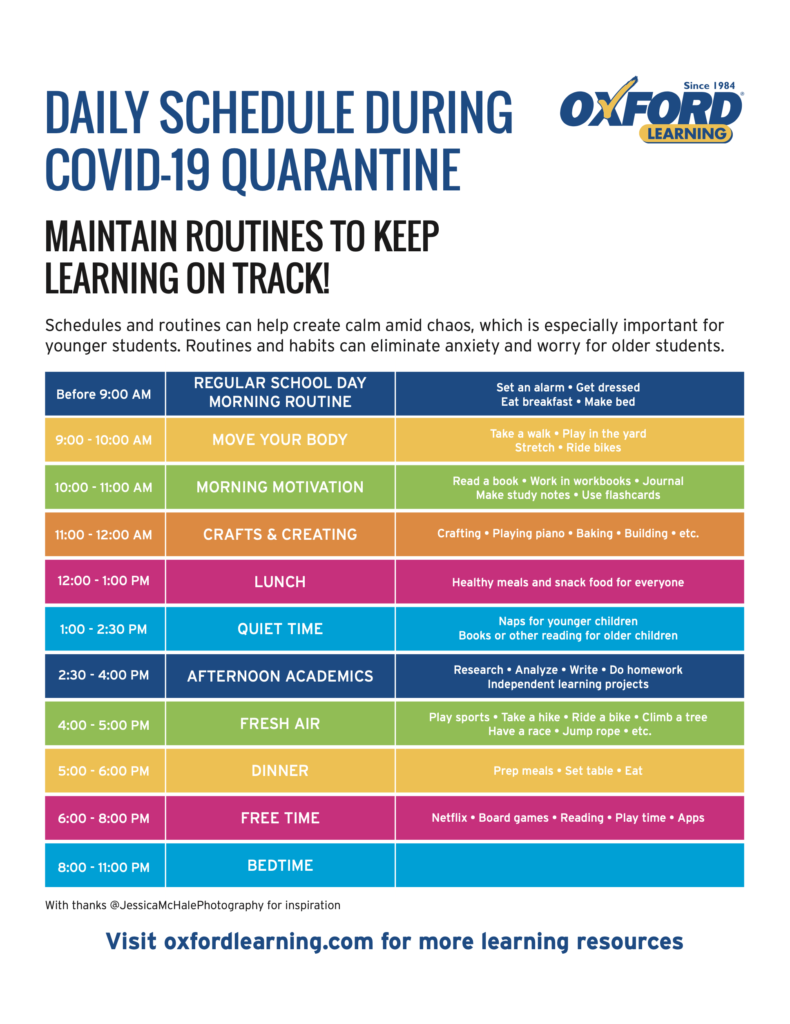The Importance of Sticking to Schedules When School’s Out

following routines can help eliminate anxiety for students
Whether it’s because of weather, strikes, scheduled vacations, or school shutdowns such as we’re experiencing right now during the Coronavirus pandemic, when school is on a break, one of the first things to be affected is the regular routine.
It’s OK To Ditch Routines Occasionally
There are times to ditch to the routine and celebrate spontaneity, such as during special events, holidays, or visits with loved ones. During times of crises when the entire world is operating on an unfamiliar schedule, letting the routine slide temporarily in order to create opportunities to connect with each other, feel our emotions, and reduce stress is not only ok, it’s necessary.
While letting the regular routine slide can at first seem exciting, as time goes on, the excitement about the lack of structure wears off quickly, which—as any parent of a young child knows—can lead to challenging behaviour. Schedule disruptions can also affect older students: this can look like declining motivation, feelings of insecurity about the world around them, or uncertainty about what’s expected of them.
Routines Create Calm and Consistency Amid Chaos
It’s normal for kids of all ages to be fearful of the unknown, whether they are trying a new food or starting a new school. While change is often a learning opportunity, it can also be stressful for children. A routine brings calm and consistency to a child’s life and helps them understand what happens next. Read more
- Sleep routines keep bodies on a regular cycle
- Chore routines help kids learn responsibility
- Routines help children develop independence and learn to take initiative
- Routines help children learn how to manage their own tasks
- Routines offer stability in times of uncertainty
Now that March Break is over, how can families reinstate something that approximates the normal routine? A daily schedule is the answer!
Kids of all ages are already used to following a schedule at school, so creating a roadmap for what the days ahead will look like can help bring a sense of normalcy during times of disruption.
5 Tips to Set a Routine at Home For Structure And Normalcy
Here’s how to create a routine at home that not only provides structure to the day but also will make the eventual transition back to the classroom smoother.
- Structure around the school day. How does the school day normally go for your child? When do your kids eat at school? When is recess? Using these questions as a guide, make decisions about how the day at home should look.
- Add play and fun to the schedule. School days are not all book learning and taking notes. School is often interactive and fun; physical movement throughout the day is important for everyone—not for just students.
- Make Reading a Priority. Add reading to the schedule in a few different ways: parent reads aloud, child reads aloud (if the child can read), and family individual reading time. If you want to extend the reading time block, go for it! Reading has many benefits for both learning and well-being.
- Schedule Screen Time. The home learning schedule won’t feel restrictive if screens are allowed for set periods of time. Learn More
- Relax the Rules. Everyone’s household will have different needs and expectations for what will be required in the days and weeks ahead. Do whatever works best for you and your family. If your children are willing to work on math worksheets or practise cursive writing, fantastic! If not, that’s ok too. Focus on learning in whatever style meets your family’s needs most, whether it’s using online resources or simply reading a book.
Not sure how to start a schedule? Oxford Learning can help! We created this sample schedule for you! Download and print your free copy.





